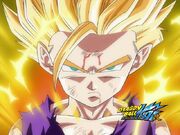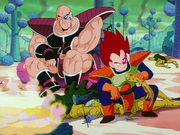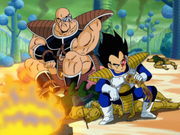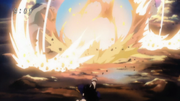(→Future: Last DBZK part set contains episode 98) |
(→Future) |
||
| Line 74: | Line 74: | ||
==Future== |
==Future== |
||
| − | There are currently no plans for Dragon Ball Kai to reach the [[Majin Buu Saga]],<ref>http://www.kanzentai.com/index.php?subaction=showcomments&id=1299126637&archive=&start_from=&ucat=&</ref> with the ''Toriko'' (another manga adaptation) taking over for ''Dragon Ball Kai's'' timeslot after episode 97. The final [[Cell Games Saga]] episode of the series was broadcast on March 27, 2011 in Japan, and January 1st, 2012 in America. The series was in syndication in Japan for exactly two years. Despite this, the series has been one of the top 10 rated anime series every week since syndication began in April 2009. The final episode of the series, which recapped the entire series and provided some closure, was released on DVD in Japan, giving the series a total of 98 episodes.<ref>[http://www.animenewsnetwork.com/news/2010-12-14/toriko-manga-gets-tv-anime animenewsnetwork.com]</ref> |
+ | There are currently no plans for Dragon Ball Kai to reach the [[Majin Buu Saga]],<ref>http://www.kanzentai.com/index.php?subaction=showcomments&id=1299126637&archive=&start_from=&ucat=&</ref> with the ''Toriko'' (another manga adaptation) taking over for ''Dragon Ball Kai's'' timeslot after episode 97. The final [[Cell Games Saga]] episode of the series was broadcast on March 27, 2011 in Japan, and January 1st, 2012 in America. The series was in syndication in Japan for exactly two years. Despite this, the series has been one of the top 10 rated anime series every week since syndication began in April 2009. The final episode of the series, which recapped the entire series and provided some closure, was released on DVD in Japan, giving the series a total of 98 episodes.<ref>[http://www.animenewsnetwork.com/news/2010-12-14/toriko-manga-gets-tv-anime animenewsnetwork.com]</ref><ref>[http://www.kanzenshuu.com/2012/03/14/funimations-final-kai-volume-coming-in-june/ FUNimation’s Final “Kai” Volume Coming in June]</ref> |
==DVD/Blu-Ray== |
==DVD/Blu-Ray== |
||
Revision as of 23:42, 3 April 2012

Dragon Ball Kai logo
FUNimation Dragon Ball Z Kai logo
Dragon Ball Z Kai, known in Japan as Dragon Ball Kai (ドラゴンボール改 「カイ」, Doragon Boru Kai; lit. "Dragon Ball Revised"), is an anime series that is a high-definition remaster and recut of Dragon Ball Z, done for its 20th Anniversary. It premiered on Fuji TV on April 5th 2009 at 9:00am just before One Piece and ended on August 25, 2011 with 98 episodes, and the two shows are being marketed together as 'Dream 9', which refers to the hour in which they both air. Two issues of Shonen JUMP have included some primary information about the series.[1]
The "Kai" (改「かい」) in the series' name means "updated," "modified," or "altered."[2] Interestingly, despite the series being only a directors cut of Dragon Ball Z, the Z has been completely removed from the title (at least in the Japanese version).
FUNimation Entertainment has been dubbing Dragon Ball Kai into English for a North American release, under the release title of Dragon Ball Z Kai (more information can be viewed below). The show has also been airing premieres on the Nicktoons since May 24, 2011 and ended on January 1, 2012. This is quite a change, as all the Dragon Ball series have almost always appeared on Cartoon Network in the United States.[3] On April 26th, 2010, 4Kids Entertainment announced the series has currently aired on The CW's Toonzai block in its 2010 - 2011 season.[4]
A new anime series based on the Toriko manga, has since debuted in in April 2011 and took over the Dragon Ball Kai time slot at 9 AM on Sunday mornings before the One Piece anime series.[5]
Series information

Comparison of aspect ratios from Dragon Ball Z Kai (left) and Dragon Ball Z (right). Click to enlarge
The series is being extensively "refreshed" for Japanese television. This is not a new animation, but rather a remastered edit that runs through certain events of Dragon Ball Z. Part of this is reformatting and extending the picture to 16:9 Widescreen. Through digital processing, the image is made vibrant. All the grime, damage and noise remaining on the "Z" film is removed, making the image much clearer in high-definition.
A comparison with the original video side-by-side shows considerable cropping to achieve the 16:9 aspect ratio. However, it seems carefully done to avoid missing anything important. The original image is not stretched, just cut where it would be more appropriate, being a "tilt and scan" or "reverse pan and scan" of the original Dragon Ball Z footage.

New ending credits with new animations of Dodoria and Zarbon (top left), The Ginyu Force (top right), Frieza (center left), Raditz (center right), and Vegeta and Nappa (bottom left)
Dragon Ball Kai includes a complete re-recording of the dialog by most of the original Japanese voice cast, as well as completely new sound design with updated sound effects. The opening and ending themes are completely new. Takayoshi Tanimoto performs the series' new opening and closing themes, "Dragon Soul" and "Yeah! Break! Care! Break!". This new opening and closing credits have newly animated appearances by most of the main cast, as well as for the villains, such as Raditz, Nappa, Vegeta, Frieza, Zarbon, Dodoria, and the Ginyu Force. There's also a new artwork clip after every intermission, such as one of Cui and Vegeta in episode 19. Unlike the original Dragon Ball Z, which only had 2 sets of eye-catchers for the entire series, in Kai it changes every few episodes to feature an appropriate character ensemble/situation.
The Garlic Jr. Saga does not air in Dragon Ball Kai. Originally lasting from episodes 108 to 117, the saga featured the return of Garlic Jr., the main villain from the first DBZ movie. The saga was completely filler and Garlic Jr. or any of his henchmen did not appear in the original manga. Because Kai stays truer to the manga, this saga has been completely cut out.
For the Androids Saga, the animation in the opening scene and closing credits has been altered a bit to fit the current storyline. New animations of Dr. Gero, Android 19, Android 17, Android 18, Android 16, and Cell appear, as well as the Super Saiyan appearances of Goku, Vegeta, Future Trunks, and Gohan. The new intro also showcases battles taking place within the saga, such as Vegeta vs. #18, Piccolo vs. #17, #16 vs. Cell, Goku vs. Cell, and ends showing a sequence of the Z Fighters standing together with their Cell Saga appearances. The ending credits are also different, showcasing Goku flying with Shenron as the faces of the main cast appear. He proceeds to transform into a Super Saiyan and the cast joins him in flight. The sequences ends with the Z Fighters standing in front of the Earth, with Shenron and Porunga in the backdrop.
Toei released the first set on DVD and Blu-Ray in September, 2009 in 4:3 aspect ratio, which is said that is how it was originally created and was only 16:9 ratio before because it cropped for HD TV.[citation needed]
Music
Dragon Ball Kai used a new background musical score by Kenji Yamamoto, composer of the Dragon Ball video games. His score was used regularly for all releases of episodes 1-95, however he was given a layoff notice from Toei Animation after it was discovered that he was infringing his music off of other artists and eventually resigned. The last few episodes of Dragon Ball Kai, as well as Japanese reruns of past episodes, made use of music recycled from Dragon Ball Z by Shunsuke Kikuchi (although the Dragon Ball Kai theme songs remained intact), however the placing of the music differed from the original series.
The American broadcast of Dragon Ball Z Kai was affected as well. The 5th American DVD/Blu-Ray volume was delayed twice, due to FUNimation replacing Yamamoto's score with the original Dragon Ball Z background score for the remainder of the English release of Dragon Ball Z Kai, for the DVDs/Blu-Rays (all episodes) and the TV Version (all episodes).
FUNimation (English Version)
"The phenomenon that defined a generation... is back for more." |
Navarre revealed during its Q3 2010 earnings conference call, on February 2nd, 2010, that its North American anime distributor FUNimation had licensed the Dragon Ball Kai series for release in the "latter part of the upcoming fiscal year." However, it was re-titled Dragon Ball Z Kai. FUNimation later confirmed the license with AnimeNewsNetwork.com. Dragon Ball Z Kai Part one was released on May 18th, 2010. The cast for Dragon Ball Z Kai was mostly the same as Z except for a few re-casts for various reasons. The English dub for the series is produced by Okatron 5000 in Dallas, TX, US at the same recording studio used for the video games of the Dragon Ball franchise. Cartoon Network, broadcaster of all original Dragon Ball media, passed on the rights to show Dragon Ball Z Kai. Instead, Nicktoons has been airing Dragon Ball Z Kai since May 24, 2010, and continues to do so.[6]

A comparison of the opening scene in Dragon Ball Kai. The shot on the left is the original uncut scene, and the right being the one that appeared on Nicktoons. It is clear to see all traces of blood have been removed from Bardock's face
The series is edited on Nicktoons to fit the intended audience, and occasionally contains different verbiage than the home release, which is entirely unedited. Some character attacks regain their correct and untranslated-proper-noun announcements in the unedited dub (i.e. "Makankōsappō" instead of Special Beam Cannon, "Kienzan" instead of Destructo Disk, etc), although some of the official English names for the attacks are retained for the broadcast version. Most other names used in the English dub remain the same (i.e. Krillin and Tien Shinhan instead of "Kuririn" and "Tenshinhan"). Less liberty is taken with the script, and episode titles are mostly literal translations of their original Japanese versions. Nicktoons' broadcast originally used Kenji Yamamoto's musical score, however it changed to Shunsuke Kikkuichi's cues after the music plagerism incident (see "Music" above). The opening theme was retained, although shortened to allow time for more commercials. The broadcast uses Vic Mignogna's version of the theme song for the full run, even though his complete version was only used for Episodes 27 - 39 on the official home video release. The ending theme is usually cut, and the credits are shown in split screen, although a shorter version of the ending has been used on occasion.
The Toonzai kids block on The CW also broadcasts FUNimation's English dub of Dragon Ball Z Kai. Their broadcast contains most of the edits of the Nicktoons version, as well as extra editing to fit the stricter broadcast standards. The broadcast has been notorious for it's questionable editing practices such as erasing Shenron from the opening credits in some episodes, colorizing Mr. Popo blue, changing halos into shining spheres, adding sparkles to Chiaotzu's fatal explosion, drawing an eye over Gohan's swollen face, and replacing dialogue considered objectionable with sound-a-like voices. Like the Nicktoons' broadcast, the Toonzai broadcast featured the Kenji Yamamoto score before being replaced with Shunsuke Kikuchi score. Aside from the Shenron edit, the opening and closing also remain the same as the Nicktoons broadcast.
Edited episodes are also available for streaming in the United States on both Nicktoons' and Toonzai's respective websites.
New Voices
- Doc Morgan – Narrator (Replacing Kyle Hebert)
- Colleen Clinkenbeard – Kid Goku, Kid Gohan, baby Trunks (Replacing Stephanie Nadolny), and Android 18 (replacing Meredith McCoy)
- Monica Rial – Bulma (Replacing Tiffany Vollmer)
- Chris Cason – Turtle and Mr. Popo (Replacing Christopher Sabat)
- Brina Palencia – Chiaotzu and Puar (Replacing Monika Antonelli)
- Bryan Massey – Oolong (Replacing Brad Jackson)
- Mark Stoddard – Dr. Brief (Replacing Chris Forbis)
- Barry Yandel – Moori (Replacing Christopher Sabat)
- Maxey Whitehead – Dende (Replacing Laura Bailey)
- Bill Jenkins – Grand Elder Guru (Replacing Christopher Sabat)
- Chris Ayres – Frieza (Replacing Linda Young, barring first episode)
- J. Michael Tatum – Zarbon (Replacing Christopher Sabat)
- John Swasey – Farmer and Dodoria (Replacing Chris Forbis)
- R. Bruce Elliott – Captain Ginyu (Replacing Brice Armstrong)
- Jason Liebrecht – Jeice (Replacing Christopher Sabat)
- Vic Mignogna – Burter (Replacing Christopher Sabat)
- Greg Ayres – Guldo (Replacing Bill Townsley)
- Jason Douglas – King Cold (Replacing Brad Jackson)
- Todd Haberkorn – Android 19 (Replacing Phillip Wilburn)
Episodes
Main article: List of Dragon Ball Z Kai episodes

Super Saiyan Goku
Toei Animation stated that the Dragon Ball Kai episodes would be edited to more closely follow Akira Toriyama's original story in the manga, resulting in a faster moving story, and to remove any damaged frames.[7] Dragon Ball Kai minimize the filler material produced for Dragon Ball Z's original production run. On the broadcast episodes, only a few minutes of filler material with no impact to the story have been left in (like Gregory's appearance at King Kai's planet, who wasn't present in the manga), probably to help the chapter reach its full 20 min.

Super Saiyan 2 Gohan
Happinet (the Japanese company releasing the series on DVD and Blu-ray) announced the Japanese DVD and Blu-ray release would have an end point of "99 Episodes (tentative)" meaning the current planned and announced episode count will end at 99.[8] Actually, Dragon Ball Kai was supposed to last for 98 episodes, but everything had originally been thrown off an entire week due to the horrific earthquake that struck Japan the prior week. The series ended in 98 episodes as of August 25th, 2011.
Dragon Ball Z Kai
The title screen translations are far more similar this time around, but are changed to fit properly into English. Edits have been made to the version appearing on Nicktoons, these include the removal of blood (which sometimes is replaced with black greyish liquid where the blood is supposed to be), overly violent moments, profanity, and others. The CW's Toonzai airings, however, are edited even more so than the Nicktoons version, due to tighter restrictions on broadcast programming. These edits include recoloring Mr. Popo's skin from black to blue, replacing dead characters' halos with glowing orbs, removing virtually all references to death in both dialogue and episode titles and renaming certain special techniques (i.e. Goku's Spirit Bomb renamed as the "Spirit Blast" and Vegeta's Galick Gun as the "Galick Blast"). Also in the beginning of the intro song, Toonzai has edited out Shenron and replaced him with a green colored sky. On Nicktoons, the series ended on January 1, 2012.
Future
There are currently no plans for Dragon Ball Kai to reach the Majin Buu Saga,[9] with the Toriko (another manga adaptation) taking over for Dragon Ball Kai's timeslot after episode 97. The final Cell Games Saga episode of the series was broadcast on March 27, 2011 in Japan, and January 1st, 2012 in America. The series was in syndication in Japan for exactly two years. Despite this, the series has been one of the top 10 rated anime series every week since syndication began in April 2009. The final episode of the series, which recapped the entire series and provided some closure, was released on DVD in Japan, giving the series a total of 98 episodes.[10][11]
DVD/Blu-Ray
The uncut box set entitled Dragon Ball Z Kai Part One was released on the 18th of May 2010,[12] and Part Two was released on the 14th of September, 2010.[13]
| Title | Release | Episode |
Region Compatiblity* |
Details |
|---|---|---|---|---|
| Dragon Ball Z Kai Part One | May 18, 2010 | 1 - 13 |
Blu-Ray A/B DVD 1/4 |
Run-time of 325 minutes, TV-PG Rating, available on DVD and Blu-ray |
| Dragon Ball Z Kai Part Two | September 14, 2010 | 14 - 26 |
Blu-Ray A/B DVD 1/4 |
Run-time of 325 minutes, TV-PG Rating, available on DVD and Blu-ray |
| Dragon Ball Z Kai Part Three | December 14, 2010 | 27 - 39 |
Blu-Ray A/B DVD 1/4 |
Run-time of 325 minutes, TV-PG Rating, available on DVD and Blu-ray |
| Dragon Ball Z Kai Part Four | March 8, 2011 | 40 - 52 |
Blu-Ray A/B DVD 1/4 |
Run-time of 325 minutes, TV-PG Rating, available on DVD and Blu-ray |
| Dragon Ball Z Kai Part Five | June 28, 2011 | 53 - 65 |
Blu-Ray A/B DVD 1/4 |
Run-time of 325 minutes, TV-PG Rating, available on DVD and Blu-ray |
| Dragon Ball Z Kai Part Six | September 13, 2011 | 66 - 77 |
Blu-Ray A/B DVD 1/4 |
Run-time of 290 minutes, TV-PG Rating, available on DVD and Blu-Ray |
| Dragon Ball Z Kai Part Seven | March 20, 2012 | 78 - 88 |
Blu-Ray A/B DVD 1/4 |
Run-time of 275 minutes, TV-PG Rating, available on DVD and Blu-Ray |
| Dragon Ball Z Kai Part Eight | June 5, 2012 | 89 - 98 |
Blu-Ray A/B DVD 1/4 |
Run-time of 250 minutes, TV-PG Rating, available on DVD and Blu-Ray |
| Dragon Ball Z Kai Season One | May 22nd 2012 | 1 - 26 |
Blu-Ray A/B DVD 1/4 |
Run-time of 625 minutes, TV-PG Rating, available on DVD and Blu-Ray |
| Dragon Ball Z Kai Season Two |
May 22nd 2012 |
27 - 52 |
Blu-Ray A/B DVD 1/4 |
Run-time of 625 minutes, TV-PG Rating, available on DVD and Blu-Ray |
| Dragon Ball Z Kai Season Three | NA | 53 - 77 |
Blu-Ray A/B DVD 1/4 |
N/A |
| Dragon Ball Z Kai Season Four | NA | 78 - 98 |
Blu-Ray A/B DVD 1/4 |
N/A |
* As stated on back of case
Theme Songs
- Opening
- "Dragon Soul" (ドラゴン・ソウル, Doragon Souru)
- Lyrics: Yoshimoto Yumi, Composition: Iwasaki Takafumi, Arrangement: Kyouda Seiichi, Vocals: Tanimoto Takayoshi
- Version 1: episodes 1-29
- Version 2: episodes 30-54
- Version 3: episodes 55-68
- Version 4: episodes 69-98
- Lyrics: Yoshimoto Yumi, Composition: Iwasaki Takafumi, Arrangement: Kyouda Seiichi, Vocals: Tanimoto Takayoshi
- "Dragon Soul" (ドラゴン・ソウル, Doragon Souru)
- Ending
- "Yeah! Break! Care! Break! (ヤ・ブレ・カ・ブレ, Yabure Kabure)
- Lyrics: Mori Yuriko, Composition: Iwasaki Takafumi, Arrangement: Kyouda Seiichi, Vocals: Tanimoto Takayoshi
- episodes (1-54)
- "Wings of the Heart" (心の羽根, Kokoro no Hane)
- Lyrics: Akimoto Yasushi, Composition: Yoko Kensuke, Arrangement: Ikuta Magokoro, Vocals: Team Dragon
- episodes (55-98)
- "Yeah! Break! Care! Break! (ヤ・ブレ・カ・ブレ, Yabure Kabure)
Trivia

Original palette

Revised palette
- Among other things, Vegeta's unique palette while on an unnamed planet in the beginning of the series has been altered, however, Nappa's armor is still different from the armor he wears on Earth. Piccolo's blood in the Raditz fight has also been recolored to purple (in DB and in this fight in DBZ, Piccolo was drawn with red blood, but purple blood in the rest of the DBZ series).
- However, when Raditz is explaining to Goku about the Saiyans, Vegeta has his original palette.
- In the ending credits, Launch is shown along with the rest of the cast. This is interesting because all the scenes from Dragon Ball Z she was in were filler that have been cut out.
- Some (but not all) of the gory moments have been edited to a degree along with nudity. In Dragon Ball Z when Piccolo fires his special beam cannon attack at Raditz and Goku, he creates a hole through both of them and a heavy amount of blood is shown, while in Dragonball Kai, no blood is seen at all, save for the holes that Piccolo creates in the centers of their bodies. More recently, in the scene where Krillin blasts a hole through Vegeta, only blood stains are seen in Kai while in Z there is blood coming out of the hole. Similarly, when Vegeta is executed by Frieza, we don't actually see the beam penetrate his chest. Nudity is notably edited as well such as in the first episode of Kai, when ever Goku (as a baby) is shown, his genitals are covered up by making objects that he is sitting on appear to be covering his genitals. In a similar manner in episode 4 of Kai, Gohan's genitals are edited as well by using his tail to cover him when he is shrinking from his Great Ape state to his normal self. All these edits are made quite possibly because Japan's television broadcasting laws have become stricter since Dragon Ball Z was first aired.

New Scene: Vegeta's Assault. Click to enlarge (1280 × 720)
- Episode 16 is the first episode in the series that includes several instances of completely new animation spliced in with the original. More than likely this was done to bridge gaps left behind when filler material was removed, so as to keep the length and pace of the episode intact; however it is also possible that this was done to replace damaged frames. This is seen again in Episode 21 at time indexes 14:25 through 14:50 and again, numerous times, interlaced with the original animation, starting at 18:44 and lasting until 21:44 (the end of the episode). The style of the animation should be considered "neo-classic" for it is designed to blend in seamlessly with the existing animation.
- In the 48th episode, ("The Angry Super Saiyan! Goku Throws down the Gauntlet!", first aired in the US on November 27, 2010), Goku announces in front of Frieza; "I am the Super Saiyan, Son Goku!" This marks the first time in the history of the English-dubbed Dragon Ball anime series that Goku has addressed himself by his full name, "Son Goku."
- Confirmed episodes of Dragon Ball Kai to have new animation inserted include: 16, 21, 22, and 24 through 54.
Gallery
References
- ↑ animenewsnetwork.com News
- ↑ "Dragon Ball Kai" at animenewsnetwork.com
- ↑ http://www.animenewsnetwork.com/press-release/2010-03-11/top-ranked-nickelodeon-announces-its-2010-11-season-programming-slate-at-annual-upfront-presentation
- ↑ http://www.animenewsnetwork.com/news/2010-04-26/dragon-ball-z-kai-to-air-on-thecw4kids-on-saturdays
- ↑ http://www.kanzentai.com/index.php?subaction=showfull&id=1292388726&archive=
- ↑ http://www.animenewsnetwork.com/press-release/2010-03-11/top-ranked-nickelodeon-announces-its-2010-11-season-programming-slate-at-annual-upfront-presentation
- ↑ http://www.animenewsnetwork.com/news/2009-03-02/toei-confirms-dragon-ball-kai-is-edited-to-follow-manga
- ↑ http://www.happinet-p.com/jp2/dragonball/#contents
- ↑ http://www.kanzentai.com/index.php?subaction=showcomments&id=1299126637&archive=&start_from=&ucat=&
- ↑ animenewsnetwork.com
- ↑ FUNimation’s Final “Kai” Volume Coming in June
- ↑ http://www.rightstuf.com/1-800-338-6827/catalogmgr/RvQUb1cFMxifOibytX/browse/item/86816/4/0/0
- ↑ http://www.rightstuf.com/1-800-338-6827/catalogmgr/RvQUb1cFMxifOibytX/browse/item/88528/4/0/0







